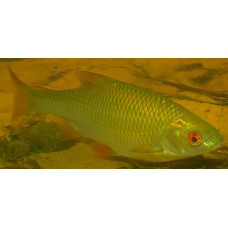Latin name
Rutilus heckelii
Other names
Rutilus heckelii
Identification
Distinctive features compared to the common roach: larger body size, smaller scales, fewer rays in the anal fin (9-10), thicker lips and blackish edges on the paired fins. In addition, the internal body cavity is lined with a black coloured film (the common roach has a colourless film).
Distribution
Aquatic in the Black and Azov Seas, entering rivers in spring to lay eggs (migration may begin in winter) and partly in autumn to hibernate.
Habitat
Semi-pelagic fish from the Azores and the Black Sea. Prefers freshwater areas.
Size
Length is usually 25-35 cm, weight often up to 1.8 kg.
Life history and Behavior
Most fish spend the winter in the sea near the mouths of rivers. The fish do not go up the rivers. Spawning takes place in reeds and grass in late March or early April, and when this is over the fish go to sea.
Food and feeding habits
Refers to an omnivorous fish, which means it can eat both plant and animal food. In general, its diet consists of: filamentous algae, molluscs, various invertebrates and their larvae, moths.
Reproduction
The main indicator for spawning is the water temperature: it should not be colder than +8 degrees Celsius. Females lay their eggs on aquatic vegetation, which also provides protection. The eggs are deposited simultaneously. The eggs, which are 1.5 mm in diameter, are attached to the stems and leaves of the plants. The eggs take 9 to 14 days to develop, after which larvae up to 6 mm in size hatch.
| Classification | |
| Phylum | Chordata |
| Class | Actinopterygii |
| Squad | Cypriniformes |
| Family | Cyprinidae |
| Genus | Rutilus |
| Species | R. heckelii |
| Features | |
| Conservation status | No information |
| Habitat | Pelagic |
| Life span, years | No information |
| Maximum body weight, kg | 1,8 |
| Maximum length, cm | 35 |
| Sailing speed, m/s | No information |
| Threat to people | Edible |
| Way of eating | Predator |
Rutilus heckelii
Tags: rutilus heckelii

